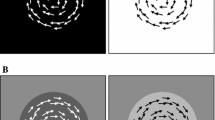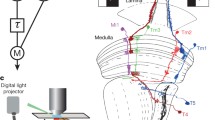Summary
Stimulus after-effects in the retinula and lamina cells of the crab are relatively brief and cannot explain the animals response to apparent motion.
Some off-neurons in the medulla show an increase of their response with increasing Exposure time. The optimum Exposure time for these neurons is between 4 and 13 s.
Neurons in the medulla can have lasting after-effects which decay exponentially during the dark time of an apparent motion stimulus, with the same time course as that exhibited by the behavioural response.
Long lasting after-effects and the dependence of off-responses on the Exposure time are characteristics of neurons with and without directional selectivity.
Similar content being viewed by others
References
Laughlin, S.B.: Neural integration in the first optic neuropile of dragonflies. I. Signal amplification in dark-adapted second order neurons. J. comp. Physiol.84, 335–355 (1973)
Laughlin, S.B.: Neural integration in the first optic neuropile of dragonflies. II. Receptor signal interactions in the lamina. J. comp. Physiol.92, 357–375 (1974 a)
Laughlin, S.B.: Neural integration in the first optic neuropile of dragonflies. III. The transfer of angular information. J. comp. Physiol.92, 377–396 (1974 b)
Sandeman, D.C., Erber, J.: The detection of real and apparent motion by the crabLeptograpsus variegatus. I. Behaviour. J. comp. Physiol.112, 181–188 (1976)
Shaw, S.R.: Polarized light responses from crab retinula cells. Nature (Lond.)211, 92–93 (1966)
Wiersma, C.A.G.: Integration in the visual pathway of Crustacea. In: Nervous and hormonal mechanisms of integration. Symp. Soc. exp. Biol.20 (1966)
Wiersma, C.A.G., Hirsh, R.: Memory evoked optomotor responses in crustaceans. J. Neurobiol.5, 213–230 (1974)
Wiersma, C.A.G., Hirsh, R.: On the organization of memory in the optomotor system of the crabPachygrapsus crassipes. J. Neurobiol.6, 115–123 (1975)
Wiersma, C.A.G., Yamaguchi, T.: The neuronal components of the optic nerve of the crayfish as studied by single unit analysis. J. comp. Neurol.128, 333–358 (1966)
Wiersma, C.A.G., Yanagisawa, K.: On types of interneurones responding to visual stimulation present in the optic nerve of the rock lobster,Panulirus interruptus. J. Neurobiol.2, 291–309 (1971)
Zettler, F., Järvilehto, M.: Active and passive axonal propagation of non-spike signals in the retina ofCalliphora. J. comp. Physiol.85, 89–104 (1973)
Author information
Authors and Affiliations
Additional information
Supported by the Deutsche Forschungsgemeinschaft ER 79/1
Rights and permissions
About this article
Cite this article
Erber, J., Sandeman, D.C. The detection of real and apparent motion by the crabLeptograpsus variegatus . J. Comp. Physiol. 112, 189–197 (1976). https://doi.org/10.1007/BF00606538
Received:
Issue Date:
DOI: https://doi.org/10.1007/BF00606538




